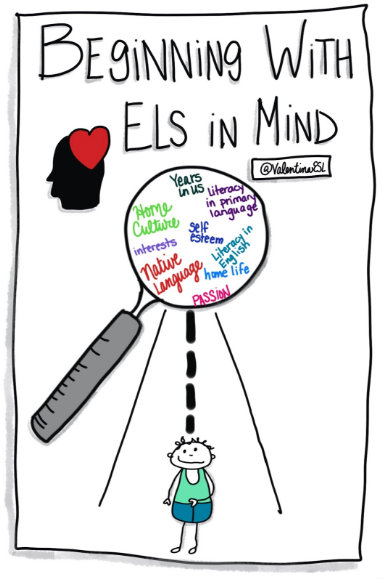Beginning the Year with English Learners in Mind
A MiddleWeb Blog
 The beginning of the school year is both an exciting time and a busy time for teachers and students. Teaching in the middle grades can add a few extra layers to the equation.
The beginning of the school year is both an exciting time and a busy time for teachers and students. Teaching in the middle grades can add a few extra layers to the equation.
Middle grade students themselves are unique in that they care so much about what their peers think. They are highly distracted, wondering if they fit in and whether they are liked.
During the middle grades, adolescent bodies are going through significant changes and that can be awkward. Students at this age embarrass easily whether the attention is caused by their teachers or by their peers.
Now add one more layer — English learner. So it’s the beginning of the school year, you’re a middle grader, and you’re an English learner.
English Learner Lens
Let’s step into those shoes for a moment. School is starting; we are in the middle grades (4-8), and English is not our first language. This seems both exciting and challenging at the same time.
As a student in upper elementary or middle school, I might feel the awkward pressures to fit in, to assimilate. I’m not sure if I want everyone to know about my other language. I don’t want anyone to notice that my family celebrates different holidays or that we eat unusual food. I just want to blend. I certainly don’t want to stand out and be teased.
But as a learner, I might find it challenging to speak in English using academic terms or to express my thoughts in written English. I’m okay socially with my friends. But when it comes to reading the books that are assigned or the textbooks in social studies, math or science, I can’t seem to keep up or really understand what’s happening.
In the Classroom
Stepping out now…English learners are one of the fastest growing subgroups in our nation. One common misconception is that English learners are all immigrants. In fact, the majority of English learners are born in the United States!
The needs of newcomer English learners and English learners who were born here and have not yet exited the program are very different. It is important that we as teachers know our English learners. Here are a few questions that will help you get started.
- Where were they born?
- If they were born outside of the US, how long have they been here?
- Are they literate in another language?
- What is their language proficiency in English in listening, speaking, reading, and writing?
One common struggle that English learners in the middle grades encounter is feeling pressure to assimilate or shed their native culture and language. As teachers we can empower students to embrace who they are and where they come from. Building self-esteem and confidence in English learners will help them feel valued for who they are.
If we can help all students learn that being different is their power, they will be free to learn and mature at greater rates.
English learners at all levels come to our classrooms with their own background experiences and knowledge. No one is a blank slate. Sometimes as teachers we have to dig deep to uncover our students’ assets because they aren’t shining brightly for everyone to see. By asking questions and getting to know our students, we can find out and tap into what they can do and what they know, and build upon that knowledge.
Long Term ELs
English learners who have been served in English as Second Language (ESL) or bilingual programs for many years and have not exited yet may be labeled as Long Term English Learners or LTELs. These students require specific linguistic instructional accommodations in order to advance through proficiency levels.
Many LTELs plateau in language proficiency because to an untrained eye they look like they are doing well in the classroom. They seem to be flying under the radar and are not rocking any behavioral boats. They go unnoticed. Don’t let these students fool you. LTELs need support too. They need specific accommodations in the classroom to help them advance in language proficiency and exit ESL.
By around fourth or fifth grade, many of these students know they are in ESL and they are ready to exit. Here’s what we can do to support them linguistically so they can succeed academically:
- Confer: Meet with English learners to set linguistic goals. Discuss with them where they are in proficiency levels in listening, speaking, reading, and writing.
- Set goals: Tell students what they need to do to meet the goals that were set. A few actionable steps.
- Follow up: Let them know that you’ll touch base with them to see how things are going. This not only lets them know you care and are invested in their learning, but also holds them accountable.
- Accommodate instruction: During instruction, provide students with sophisticated discourse/sentence frames to use in speaking and writing. Each content area will use different frames. For example, in science you might use frames such as “Based on the experiment…” or “My prediction is…because…” Students need to learn how to speak and write using advanced forms of language structures. Their writing will mirror their speaking. If we want them to write at advanced levels, we must first get them speaking at advanced levels. Discourse or sentence frames are used as a scaffold.
In Conclusion
Keep in mind that English learners in the middle grades are capable of learning content while acquiring English (and experiencing adolescence). In fact, it is key to their success. We just have to be mindful of the way we support their journey. They can do this and so can we!






























